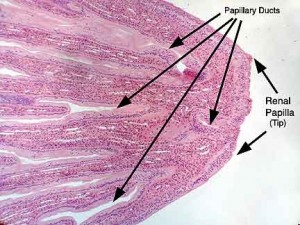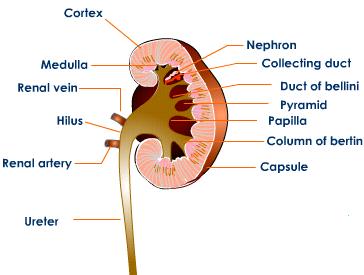Renal papilla Definition
It is the apex or highest point of each renal pyramid that projects into a calyx. In other words, it is any of the triangular tissue sections that constitute the medulla – the white fatty material of the kidneys.
Renal papilla is that component of the kidney from where the urine is secreted towards a minor calyx coming from the renal pyramid. Renal papilla consists a lot of papillary ducts. A normal human kidney contains 7 to 22 renal papillae.
According to a study*, there are 2 kinds of renal papillae. These are given below:
- Simple Papilla
- Complex Papilla
Furthermore, complex papillae are classified into 6 types:
- Bifid Fused
- Trifid Fused
- Bifid Separate
- Cruciate Fused
- Trifid Separate
- Cruciate Separate
Renal papilla Origin
The renal papilla originates from the minor calyx and ends right at the starting of the renal pyramid acting as a tiny protuberance. Renal papilla is very thin as compared to other components of the kidney.
Renal papilla Location
It is a part of the kidney. The renal papillae are located on the edges minor calyces, between the intersection of the medulla and the calyces. Moreover, renal papillae and the renal pelvis are separated by an epithelium lining. Simple papilla and the bifid papilla are generally observed in kidney’s hilus region. On the other hand, the remaining two types of papillae are found in the cranial area.
Renal papilla Appearance
The surface of this tissue section looks like a sieve. It comprises numerous small apertures (openings) from which droplets of water can pass. When observed through a microscope, renal papillae appear like lumps and projections. The shape of a renal papilla is analogous to a levelled cone. The lengths of renal papillae can be anywhere between 6.5mm and 14mm depending on the kind of papilla.
Renal papilla Function
It transports urine produced in the cortical section of the kidney to the cup-like cavities (calyces) where the urine gets accumulated before passing into the bladder through the ureter. Moreover, this process is aided by minor calyces’ infundibula. In simple words, the urinary transportation from the cortical section to a calyx’s lumen is possible because of renal papillae.
Renal papilla Disorders
Certain toxic chemicals, known as nephrotoxins, are harmful to the kidney and cause damage to the renal papillae. This can lead to the death of cells in this kidney region and give rise to a condition, known as Renal Papillary Necrosis. This disorder commonly arises due to dehydration, along with NSAIDs like Acetylsalicylic acid, Phenylbutazone, and Ibuprofen. This condition is often accompanied by various symptoms such as back pain, hazy urine, fever and, polyuria. Apart from this, renal fibrosis is another condition which is identified by the accumulation of connective tissue over the kidney parenchyma.
Renal papilla Causes
The main cause of Renal Papillary Necrosis is the obstruction in the supply of blood arising due to ischemia. Moreover ‘POSTCARDS’ are other major causes of Renal Papillary necrosis:
- P – Pyelonephritis
- O – Obstruction in the Urinogenital Tract
- S – Sickle Cell Disease
- T – Tuberculosis
- C – Cirrhosis
- A – Alcohol Abuse
- R – Renal Vein Thrombosis
- D – Diabetes Mellitus
- S – Systemic Vasculitis
Renal papilla Treatment
As of now, there is no exact treatment of Renal papillary necrosis. The only way to control RPN is to check the diseases that further lead to necrosis. According to a report, doses of relaxin can also help in decreasing the risk of renal diseases.
Renal papilla Pictures
Check out some pictures of this physical structure to get an idea about its appearance.
Picture 1 – Renal papilla
References:
http://en.wikipedia.org/wiki/Renal_papilla
http://medical-dictionary.thefreedictionary.com/renal+papilla
http://www.britannica.com/EBchecked/topic/497964/renal-pyramid#ref269442



No comments yet.